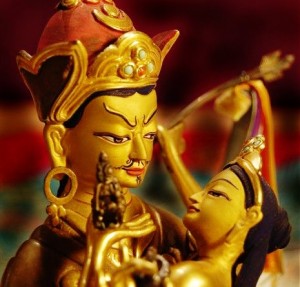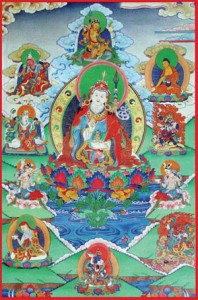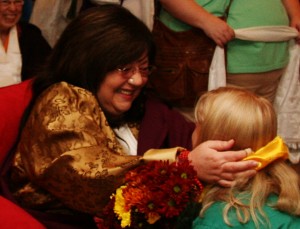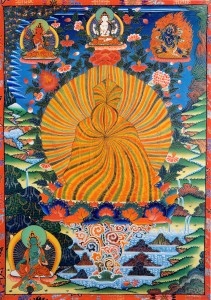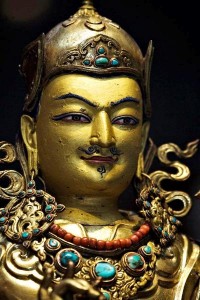The following is an excerpt from a teaching by Jetsunma Ahkon Lhamo called “Guru Yoga”
If Guru Rinpoche is the Nirmanakaya form of the Buddha, we should also think that he is Enlightenment itself, that what we are seeing is merely the tip of the iceberg. It’s the way in which that function of enlightenment appears in the world. Is it always so? Does enlightenment appear in the world? Why does it? What is it when it appears in the world and what is it when it doesn’t appear in the world? What is it, actually?
Very hard to describe what enlightenment actually is. Because when we describe enlightenment, it’s like looking at the sky through a tiny peephole. You can’t really get what it is. You might be able to see the spaciousness of it. You might even be able to hook into a star. You might even be able to describe color and the way the star glimmers. But from looking through a peephole, you simply cannot understand what the sky is. It’s impossible. And from our point of view, it is impossible to understand what enlightenment is by looking as we do through our little peephole.
We can only understand enlightenment really in terms of what it is not. We can understand, for instance, that enlightenment is the state free of conceptualization. We can understand that it is a state free of contrivance. We can understand that it is a state unlimited by ordinary view, ordinary perception. But we can’t really understand what else there is. In fact if you described “some thing else,” you’ve lost the pristine nature of enlightenment, because if you do that, you are conceptualizing. You are limiting, and you are contriving, an image or an experience. That’s the way our minds work. That’s the only way that we have.
When the Buddha described himself, he described himself as being “awake”. Simply that. We can’t even understand what that means because we immediately want to say, “Awake to what? And what were you asleep in before?” We try to understand in those ways. It’s either/or, black or white. Our minds hook on to something. And for that reason, we cannot fully and completely understand enlightenment.
In short, enlightenment has been described as the primordial wisdom state, that state which is like luminosity. But it isn’t luminosity because when we think of luminosity, we think of light and light is “some thing.” This state called enlightenment is not a thing at all. It is beyond “thing-ness” and “no thing-ness.” It is beyond form and formless. It is beyond self and other. It is beyond up and down. It is beyond hot and cold. It is beyond dark and light.
Copyright © Jetsunma Ahkon Lhamo. All rights reserved

